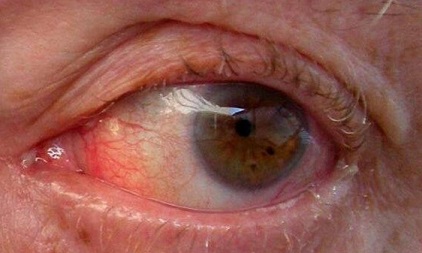Glaucoma News: Study Deciphers The Role Of GGT1 In Glaucoma Pathogenesis With The Aim Of Identifying Possible Therapeutic Strategies
Nikhil Prasad Fact checked by:Thailand Medical News Team Nov 23, 2023 2 years, 1 month, 2 weeks, 14 hours, 18 minutes ago
Glaucoma News: Glaucoma, a chronic and progressive optic neuropathy, is a global public health concern with millions suffering from irreversible blindness. The mainstay of current therapeutic strategies revolves around managing intraocular pressure (IOP), but cases with normal IOP at diagnosis underscore the need for exploring alternative mechanisms contributing to glaucoma pathogenesis. Recent research has identified ferroptosis, a distinct form of programmed cell death, as a potential player in retinal ganglion cell (RGC) loss in glaucoma.

This study covered in this
Glaucoma News report, was conducted at Huizhou Municipal Central Hospital in Guangdong, China and dives deep into the intricate relationship between ferroptosis and glaucoma, unveiling a novel regulatory mechanism involving gamma-Glutamyl transpeptidase 1 (GGT1) and its impact on autophagy in RGCs.
The Global Burden of Glaucoma
In 2020, the global burden of glaucoma in individuals over 50 years old reached a staggering 3.6 million cases of blindness. Glaucoma is characterized by progressive visual field impairment and structural damage to the optic nerve head. The primary risk factors include advanced age, elevated IOP, high myopia, and a positive family history of glaucoma. The loss of RGCs, essential neurons for maintaining visual function, contributes to visual field defects and various disturbances in vision. IOP-induced apoptosis of RGCs and oxidative stress play central roles in the pathophysiological changes associated with glaucoma.
Current therapeutic strategies, encompassing topical treatment, laser therapy, and glaucoma surgery, primarily focus on reducing IOP to inhibit glaucoma progression. However, a subset of glaucoma cases presents with normal IOP at diagnosis, prompting a quest for alternative therapeutic targets. This study, therefore, explores the potential role of GGT1, a member of the gamma-Glutamyl transpeptidase family, in glaucoma pathogenesis.
Gamma-Glutamyl Transpeptidase (GGT) Family and GGT1
The GGT family comprises 13 identified genes, with GGT1 emerging as a significant player in human cancers. GGT1 is a membrane-bound extracellular enzyme that breaks down glutathione (GSH), providing cysteine essential for cell survival and preventing excessive oxidative stress and ferroptosis. In glioblastoma cells, inhibition of GGT1 facilitates cystine deprivation-induced ferroptosis.
Interestingly, GGT1's role in RGCs has not been extensively explored. This study aims to bridge this gap and uncover potential associations between GGT1 and glaucoma pathogenesis.
GGT1 Expression in Glaucomatous RGCs
To assess GGT1's involvement in glaucoma, the study analyzed GGT1 expression in RGCs from DBA/2J mice with spontaneously chronic high intraocular pressure glaucoma. Comparative analysis with wildtype mice revealed a significant decrease in GGT1 levels in glaucomatous RGCs, suggesting a potential association between GGT1 and glaucoma progression.
OGD/R-Induced Cellular Damage and Iron Homeostasis
The study utilized oxygen-glucose dep
rivation/reoxygenation (OGD/R) treatment on RGC-5 cells to mimic the conditions of glaucomatous stress. OGD/R treatment induced serious cell damage, aberrant iron homeostasis, and oxidative stress in RGC-5 cells. This was evidenced by reduced cell viability, altered mitochondrial morphology, and an increase in reactive oxygen species (ROS) levels. Importantly, both GGT1 knockdown and OGD/R treatment led to a decrease in GGT1 expression, suggesting a potential link between GGT1 and glaucoma-induced cellular damage.
GGT1's Protective Role Against Ferroptosis
Intriguingly, GGT1 overexpression significantly alleviated OGD/R-induced cell damage, improved mitochondrial morphology, and reduced cellular iron accumulation. These protective effects of GGT1 were further validated by the use of ferroptosis inhibitors, emphasizing GGT1's role in inhibiting ferroptosis in RGC-5 cells. Ferroptosis, characterized by iron-dependent cell death, has been implicated in the loss of RGCs in glaucoma. GGT1's ability to mitigate ferroptosis provides a novel avenue for potential therapeutic interventions in glaucoma.
GGT1-Mediated Inhibition of Autophagy
Mitochondrial impairment and autophagosome accumulation are notable features of OGD/R-treated cells. GGT1 overexpression demonstrated a significant improvement in mitochondrial morphology and a reduction in autophagosome accumulation, highlighting GGT1's role in mitigating autophagy in RGC-5 cells. Conversely, GGT1 knockdown exacerbated these phenomena. The study identified a potential interaction between GGT1 and glutamate cysteine ligase catalytic subunit (GCLC), implicating GGT1 in the regulation of both autophagy and ferroptosis.
Interplay Between Ferroptosis and Autophagy
The study further explored the intricate interplay between ferroptosis and autophagy in glaucomatous RGCs. Inhibition of autophagy with wortmannin alleviated ferroptosis induced by erastin, suggesting a potential crosstalk between these two cellular processes. This observation provides valuable insights into the underlying mechanisms of cell death in glaucoma and opens avenues for future research targeting autophagy to restrain ferroptosis.
GGT1's Interaction with GCLC and Therapeutic Implications
The study identified GGT1's interaction with GCLC and its role in inhibiting autophagy and ferroptosis. Depletion of GCLC reversed the protective effects of GGT1 overexpression, underscoring the importance of this interaction in cellular homeostasis. GCLC, known for its role in glutamate regulation, has a glutathione-independent mechanism in inhibiting ferroptosis. The study's findings indicate that GGT1 may serve as a promising candidate for glaucoma therapy through its regulation of autophagy and ferroptosis.
Conclusion
In conclusion, this comprehensive study elucidates the intricate relationship between GGT1, autophagy, and ferroptosis in the context of glaucoma. GGT1 emerges as a potential therapeutic target, with its ability to suppress OGD/R-induced cellular damage, inhibit ferroptosis, and regulate autophagy. The identification of GGT1's interaction with GCLC further underscores its importance in cellular homeostasis. As the scientific community eagerly awaits further in vivo studies to validate these findings, the study provides a solid foundation for future research and potential therapeutic innovations in the challenging landscape of glaucoma treatment.
The study findings were published in the journal: Cureus.
https://www.dovepress.com/ggt1-suppresses-the-development-of-ferroptosis-and-autophagy-in-mouse--peer-reviewed-fulltext-article-EB
For the latest
Glaucoma News, keep on logging to Thailand Medical News.
